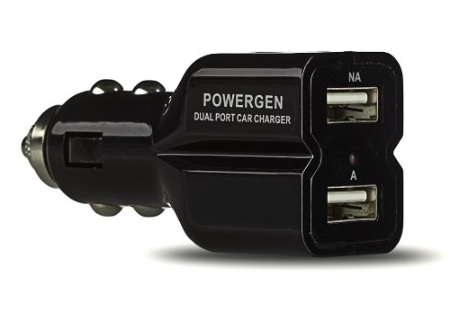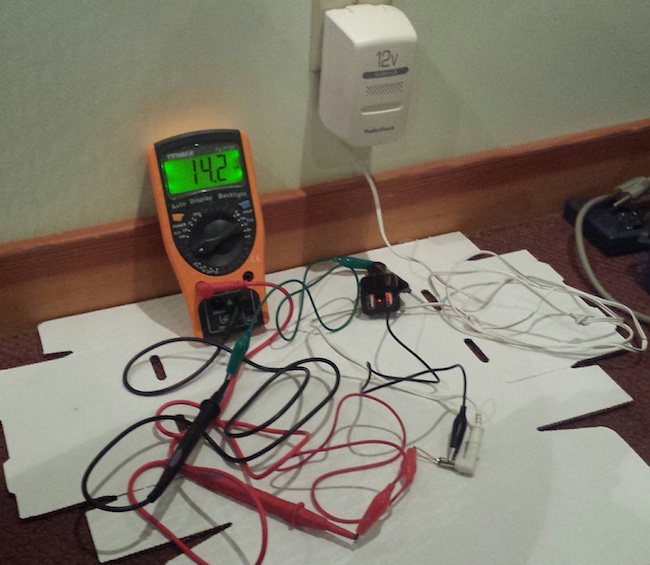Standby Current of a USB Car Charger

How much current does a typical USB car charger consume, when nothing is charging? Zero? Microamps? Milliamps? Is it enough to be concerned about draining the car’s battery? There’s no better way to find the answer than direct measurement, so let’s go!
My 2016 Mazda CX-5 has two built-in USB ports, which can theoretically recharge my mobile phone while I’m driving around, but the rate of charge is so slow as to be nearly useless. In an hour of driving, it might raise the phone’s charge level by 15%. To get faster charging, I purchased a USB car charger that fits in the 12V jack in the car’s center console: the ubiquitous jack that was once the cigarette lighter in years gone by, but has now been repurposed as a place to plug in dash cams, DVD players, and other car accessories.
The new USB car charger works fine, and can recharge my phone from zero in about an hour, but it leaves me with a lingering worry. The 12V jack in the 2016 Mazda is not switched by the ignition, but is powered all the time regardless of whether the car is on or off. That means when the car is sitting parked, with the engine off, the USB charger is still drawing current. If I were foolish enough to leave some power-hungry appliance connected, it could quickly drain the car’s battery. But even with nothing connected, the USB charger will still draw some standby current. To measure it, I put together a quick test involving a 12V wall supply, the USB charger, a multimeter, and lots of alligator clips.

The answer: the USB charger’s standby current is 14.2 mA. I would have guessed microamps, so I was way off. It doesn’t help that the charger has an LED that’s continuously illuminated whenever it’s powered.
Is a constant 14.2 mA draw enough to worry about discharging the car’s battery? Probably not. From a few quick searches, I learned that a typical car battery has a capacity of around 40 ampere hours. At 14.2 mA, it would take 2817 hours or 117 days to completely discharge the car’s battery. Assuming I drive the car every day, then, it’s not a concern. Even parking the car for a week or two should be fine. But if I ever need to leave the car in storage for an extended period of time, that 14.2 mA could add up. Of course the car itself has its own standby current draw for the anti-theft system and keyless entry, so the USB charger may not even be the largest concern. For typical driving, at least, it appears the USB charger’s standby current draw won’t be a problem.
Read 11 comments and join the conversation11 Comments so far
Leave a reply. For customer support issues, please use the Customer Support link instead of writing comments.


Wow, that’s really bad…. well that what I though at first
But
14.5 mA @ 12V is 170mW
Working on the assumption that the charger can output 1.5 A(what a lot of modern smartphone chargers output) the chargers output is 7.5W
in other words… standby power is 2.2% which is pretty damn good..
It gets even better if the Charger is +2A(Ipad chargers etc, multiple Chargers) I would not be surprised if this could output 15W which make 170mW a pittance..
Interesting test, I’ve got a car that I don’t regularly drive (maybe a week or two between) that also has always-on outlets, and I usually unplug everything just to make sure.
Something to consider is that this isn’t the only thing drawing current in the car when it’s off. Generally the current draw should be less than 50mA, so if you’re adding 14.5mA to that, you’re increasing the draw by ~29%.
Another one is you don’t really care about dropping battery capacity to 0%, but how much you can pull until it will no longer start the car, and that will vary based on engine size, battery type, etc
Assuming a 40Ah battery that will still start the car at 50% (20Ah), you’d have 400 hours (~16 days) at 50mA until you hit that point. Increasing that to 64.5mA drops it to around 300 hours, or just under 13 days. So leaving it plugged in would mean the difference between being able to leave it for two weeks or not.
@Ben It’s probably 4.2A(20W) total, going by the specs on the Amazon page.
I had a small 1W solar top up charger for just that reason – can’t charge a dud battery but supplies 20-50mA in bright condition, and fits nicely on the dash with double sided tape. Also a conversation starter at parties.
I had the same problem. Added a op-amp and a pic10f202 with 2 hour timer code. Shuts down USB via FET in 2 hours
No more drained car battery.
A different Ben(what a great name) bring up a valid point, however, how much you can discharge your battery before you cant start will vary from car to car..
It would depend on the size of the battery, the size of the engine, the compression ratio of the engine, the gearing of the starter… etc
There is a good rule of thumb for other reasons, never discharge a starting battery below 65%(I think) other wise you will drastically shorten it’s life..
Actual current draw is likely more like 1-2mA, once you pop it open and desolder the power LED.
what idiot wrote this? a car battery is considered too low to start at 12v and fully charged at 12.6v on my 2013 truck if i leave the charger plugged in for > 10days, its not able to start.
furthermore car batteries are rated in CA not Ah. they are not deep cylce batteries, they are only designed to provide the current necessary to get the engine(and alternator/generator) running.
A car battery’s voltage will remain near 12V until it’s almost completely discharged. You can’t measure the state of charge by measuring the voltage, except in an approximate way by referring to the discharge curve for your particular brand and model of battery.
CA (cranking amps) measures how much current the battery can deliver, not how much energy it can store. The CA figure is helpful for telling if the battery can start your engine, but it’s not relevant to this question. See https://en.wikipedia.org/wiki/Automotive_battery#Terms_and_ratings
You’re right that car batteries aren’t designed for deep discharging.
I measured two 12v USB car chargers today. One was rated at 3A and the other at 1A. The larger one pulled 21mA at idle and the smaller one 11mA. I didn’t Jane much use for the little one so I tried to take it apart and failed (I was going to desolder the LED to see how many mA it consumed). Instead, I drilled out the LED until it stopped glowing. I effected only a 0.5mA drop in current, so by my experimentation, don’t worry about LED power consumption.
Ah and CA are two different parameters of a battery. Ah relates to the maximum amount of power the battery can store whereas CA is the maximum current the battery can deliver. These are the main points considered by the vehicle designer when deciding what size of battery is required for the vehicle in question.
The idle current of a USB charger depends on how well designed it is. It should not require more than 0.05 mA in idle mode and could be as low as 0.005 mA. However, the cost of the charger will rise with sophistication e.g. the cost of the components used etc. In the end you get what you’re prepared to pay for.